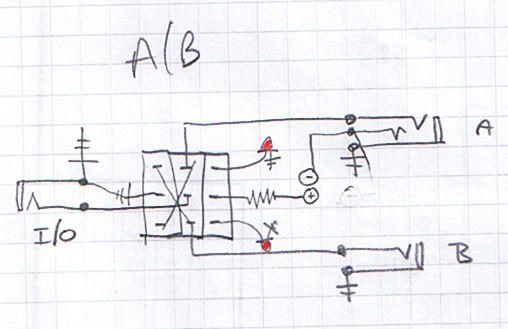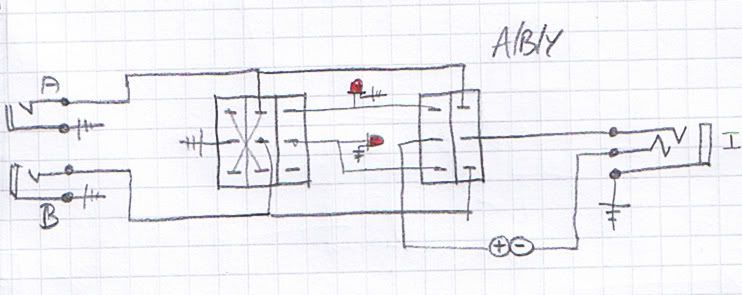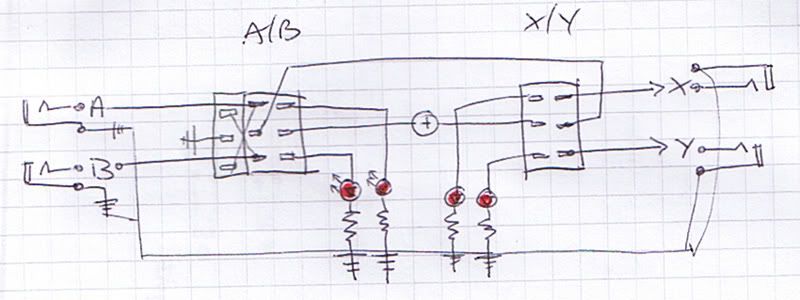|
|
Post by flateric on Jan 25, 2009 4:53:11 GMT -5
OK, my fellow guitarist has seen my little AB/XY box and wants one for 3 guitar inputs and one common output to amp.
An A/B/C box.
I've seen a LoopMaster type which is an A/B box on one footswitch with a C on another footswitch which over-rides the A/B. Its not ideal.
I've also considered a simple row of 3 DPDT switches so each of the three inputs can be toggled on or off to feed into the output.
This has the problem of allowing 1,2 or 3 inputs simultaneously, which is a bad thing.
I think there should be a way of making something cleverer - 3 switches that will over-ride the previous selection and allow only one input at a time. The guitarist has this on his Mesa pedal board for slecting one of 4 channels on his amp.
Question is, how to do it?
|
|
|
|
Post by newey on Jan 25, 2009 9:36:30 GMT -5
Does he want the ability to have all 3 outputs "off"? If not, and one of the ouputs can always be active, 2 3PDT stompbox switches could do the trick. One pole of the first switch would be a bypass to "A" out, second pole would be for the LED, third pole would select "B" out. On the second switch, one pole would bypass the first switch, one would control the LED, and the third would switch in output "C". He'd only have 2 LEDs, no LED lit would indicate output A was the active one, B and C would be indicated by their respective LEDs. Just an idea, mind you, I'd have to spend hours figuring how to wire this, and it would probably be wrong anyway.  I also don't know if daisy-chaining these switches in this manner might cause a "pop" when switching. |
|
|
|
Post by ashcatlt on Jan 25, 2009 12:21:11 GMT -5
Is it just me, or is this getting a little absurd? Does this guy need to be changing guitars in the middle of a song? Does he not have enough cables underfoot as it is? Is it that difficult to unplug one guitar and plug in the next?
I know that's not particularly helpful. I'm thinking that the switching you're looking for - 3 switches, only the most recent of which is active - might go a bit beyond simple passive switching. It could probably be done with some active "logic" circuit using flip-flops and whatnot.
|
|
|
|
Post by flateric on Jan 25, 2009 13:25:01 GMT -5
No thats not at all helpful, to be honest! I don't think its at all an absurd request. I reckon it can be done. It may involve more than just passive switching. If there's anyone around that would know about this stuff then I reckon it would be you guys here.
He uses 3 guitars at a gig - a les paul, a strat and a tuned-down telecaster for a couple of songs. He wants to be able to just put down one guitar, put on the other and tread on a pedal and go straight into the song. He doesn't want to faff about pulling out jackplugs and muting his amp then plugging in the other guitar he just picked up.
Newey - I think what you have described is the A/B/C loopmaster type pedal I outlined above as being do-able but not ideal.
|
|
|
|
Post by JohnH on Jan 25, 2009 14:43:17 GMT -5
I think the part where we want the last switch pushed to override the others, puts it beyond what can be done with just stomp-box switches. You can easily imagine the circuit you described where one switch selects B or C and the other selects A or whichever of B/C the first switch picked. But you can’t get three simple switches, one for A, B and C to override each other. You can have B override A and C override A and B, but then A can’t override B and C
To do that would need, either:
[brainstorm]
1. A mechanical array of switches, such as on an old push-button car radio, that 'un-click'each other as you push them in (in principle – but gig-tough)
2. Three momentary non-latching footswitches and three electro-mechanical relays, wired so that the last one latches on, and also cuts power to the other two. A fair amount of current is needed to power them, so not really practical for batteries, plus, would need testing and care to ensure avoidance of induced clicks as the relay coils engage and disengage. The only advantages of this scheme are that it does not require any understanding of semiconductors, and the signal only sees passive switching through the relays. Actually I kind of like it, its bulky, old-fashioned, high power consuming and has a sort of retro 50’s (or even 20’s) cool!
3. Active electronics – each signal gets an opamp or JFET buffer, followed by an electronic switch or ‘ducking‘ circuit, such as used in many channel switching control operations in amps, controlled bythree non-latching footswitches and some logic to remember which was pressed last, a mixer and another buffer. Not a hard piece of electronics to spend a couple of months designing as a high school project, but, I’m not doing it! Risk here includes keeping the signals clean as they go past all that circuitry.
[/brainstorm]
I think the best answer in practice is to go back to just three stomp-box switches, each with an input that gets connected or disconnected to the output, and its own LED. They are all separate and can all be on or off. So to change guitars, you step on one switch to turn it on and another to switch the previous one off. I think that’s not too much to ask for a guitar change, which is between songs and hence you can afford another second more than for other mid-song stomp-box operations. The LEDs tell clearly what is on and what is off. The guitars won’t play nicely if more than one is on, but then they wouldn’t need to. I don’t foresee any particularly bad spurious noises in that moment when two are connected. You can also switch the first guitar off first, then switch the second one on. For the same reasons as for the previous design, you could use a third pole on each switch, all three wired in series to shunt the output to ground, but only when all are off.
How about that?
John
|
|
|
|
Post by flateric on Jan 25, 2009 15:31:49 GMT -5
Yes, I think thats the most practical solution within the confines of a budget project. I'll put the proposal to him and see what his views are. I think this is better 'logic' than the Loopmaster or Morley A/B/C type.
|
|
|
|
Post by flateric on Jan 27, 2009 13:15:35 GMT -5
Here's my set of 4 schematics for splitter boxes: 1) straightforward A/B box with LED's, works 'both ways round'  2) ABY box with LED's - takes guitar input and splits to either A OR B OR both, for 1 guitar, 2 amps  3) ABC box, choose between 1 of 3 inputs to one common output, or 1 input to one of 3 outputs (not yet tested this one...)  4) My own favourite, the A/B + X/Y choose from 1 of 2 inputs and choose from 1 of 2 outputs. I use this for 2 guitars into either amp or tuner  |
|